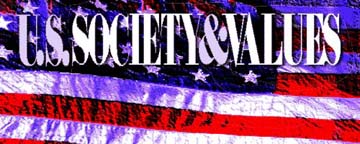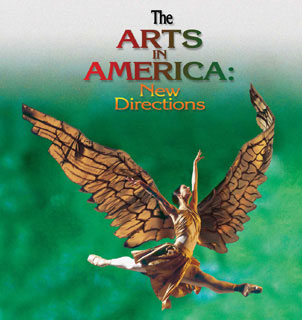

The Arts in America: New Directions
An electronic journal of the U.S. Department of State,Volume 8, Number 1, April 2003
(Download Adobe Acrobat version)

From the EditorsIn his recent book American Visions: The Epic History of Art in America, the Australian-born art critic Robert Hughes identifies one of the core American experiences as "starting over, leaving behind what you once were." For Hughes this does not mean wiping the slate clean but rather a complex interaction with previous tradition. "Somewhere inside the American museum," Hughes writes, with a touch of humor, "there is always a small buried image of the immigrant getting off the boat with his luggage: boots, a Bible -- or 27 Rembrandts." This kind of starting over is what artists do every day in making art. Starting from the ground up is also what we editors had in mind when we asked some of America's leading experts in various art forms to tell us about the state of their fields. What's new, for example, in dance or the visual arts? Who are the most notable artists working in theater and music? How do current trends in movies and literature fit in with historical traditions? Because any generalizations about the arts must be suspect in a country housing some 1,200 symphony orchestras, 117 professional opera companies, more than 400 dance companies, and 425 nonprofit professional theaters, each expert's answer to these questions will necessarily be a partial answer. That's why we have included a range of views -- critics, working professionals in each field, portraits of the artists themselves. And, naturally, our experts sometimes disagree with one another. A diversity of opinions seems only fitting in a country where there is no ministry of culture, no official view of the best forms of art. Yet this journal also reveals certain common themes. One is the increasing internationalization of art -- the way contemporary American art forms are constantly enriched by the movement of artists and ideas across borders and vice versa. Another is what one critic calls "hybridity" -- borders between art forms are breaking down as many artists work in cross-disciplinary ways. The dances of Mark Morris or Bill T. Jones sometimes incorporate spoken words; the visual artist Matthew Barney makes epic films that have the look of Hollywood movies. Another vital trend in the way new work gets created these days is the intricate cross-pollenization between the traditional centers of creativity on America's coasts and the country's less populated regions. In his overview essay, critic Terry Teachout makes the point that some of New York City Opera's most exciting new work originates at Glimmerglass Opera, a small company in a small town in upstate New York. What is at the root of all the ongoing creative ferment that this journal documents? In our opening interview, Dana Gioia, the poet who is chairman of the National Endowment for the Arts, identifies one likely source: "The reason that America has had this diversely distinguished history of art, this unprecedented breadth of achievement -- ranging from movies to abstract expressionism to jazz to modern literature -- is because America was and is a society that recognizes the individual freedom of its citizens." |

